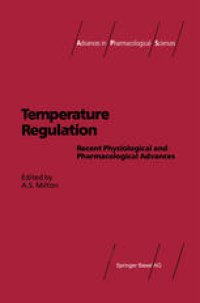
Ebook: Temperature Regulation: Recent Physiological and Pharmacological Advances
- Tags: Zoology, Pharmacology/Toxicology, Biochemistry general, Endocrinology
- Series: Advances in Pharmacological Sciences
- Year: 1994
- Publisher: Birkhäuser Basel
- Edition: 1
- Language: English
- pdf
Many advances have been made in the field of thermoregulation in the past few years. These include our understanding of Fever, which is now considered not simply a rise in deep body temperature foHowing infection, but just one aspect, though perhaps the most easily measured, of the Acute Phase of the Immune Response. Classification and identification of the Cytokines and the availability of recombinant material has greatly aided this research. Similarly, our understanding of the Hypothalamo-Pituitary Adrenal Axis has altered our way of thinking about temperature regulation. Of importance are the problems associated with adverse climatic conditions and survival, and the problems encountered by the neonate and the hibernator. At the biochemical level, our knowledge of the control of heat production and the role of brown adipose tissue is rapidly advancing. All these issues and many others were discussed at a Symposium 'Thermal Physiology 1993' held in Aberdeen, Scotland in August 1993 under the auspices of the Thermal Physiology Commission of the International Union of Physiological Sciences. Six main aspects of the subject of temperature regulation are included in this book, namely, Fever (including the Acute Phase of the Immune Response and Thermoregulatory Peptides), Neurophysiology of Thermoregulation, Neonatal Thermoregulation, Mechanisms of Heat Production, Ecological and Behavioural Thermoregulation, and Emerging Themes in Thermoregulation.
Content:
Front Matter....Pages i-xii
Effect of Peripheral Corticotrophin-Releasing Factors on Febrile Responses....Pages 1-10
Fever Induction by a Cytokine Network in Guinea Pigs: The Roles of Tumor Necrosis Factor and Interleukin-6....Pages 11-16
Cytokines in Endotoxin Tolerance....Pages 17-22
Effects of Immunomodulators and Protease Inhibitors on Fever....Pages 23-27
Endogenous Steroids Limit the Magnitude of Febrile Responses....Pages 29-34
The Role of Heat Shock Proteins (HSPs) and Interleukin-1 Interaction in Suppression of Fever....Pages 35-39
Body Temperature Elevation Per Se Induces the Late Phase Syndrome....Pages 41-46
The Absence of Fever in Rat Malaria is Associated with Increased Turnover of 5-Hydroxytryptamine in the Brain....Pages 47-52
Prostaglandins and the Acute Phase Immune Response....Pages 53-58
Apparent Dissociation between Lipopolysaccharide-Induced Intrapreoptic Release of Prostaglandin E2 and Fever in Guinea Pigs....Pages 59-64
Thermoregulatory Responses of Rabbits to Combined Heat Exposure, Pyrogen and Dehydration....Pages 65-70
Fever and the Organum Vasculosum Laminae Terminalis: Another Look....Pages 71-74
Lipopolysaccharide (LPS)-Induced Fos Expression in the Brains of Febrile Rats....Pages 75-79
Analysis of Body Temperature and Blood Protein in Hypothermic Syrian Hamsters and Rats....Pages 81-85
Neurophysiology of Thermoregulation: Role of Hypothalamic Neuronal Networks....Pages 87-92
Effect of 5-HT Receptor Agonists or Antagonists on Hypothalamic 5-HT Release or Colonic Temperature in Rats....Pages 93-101
Temperature Sensitivty of Rat Spinal Cord Neurons Recorded in Vitro....Pages 103-108
The Effect of Ambient Temperature on the Modulation of Thermoregulatory Mechanisms by Selective Opioid Peptides....Pages 109-114
Regulation of Body Temperature: Involvement of Opioid and Hypothalamic GABA....Pages 115-120
Bilateral Difference in Tympanic Temperatures Reflects that in Brain Temperature....Pages 121-126
Temperature Interhemispheric Brain Asymmetry as a Sign of Functional Activity....Pages 127-131
Cerebral and Related Temperatures in Normothermic Subjects....Pages 133-138
Non-Thermometric Means of Assessing Changes of Brainstem Temperature: The Question of Selective Brain Cooling in Humans....Pages 139-144
Effects of Selective ?-Adrenergic Blockade on Control of Human Skin Blood Flow during Exercise....Pages 145-149
Acclimation to 3 Different Climates with the Same Wet Bulb Globe Temperature....Pages 151-157
Sensible Heat Loss after Systemic Anticholinergic Treatment....Pages 159-164
Neuropeptide-Y (NPY) Reduces Cutaneous Microcirculatory Blood Flow and Increases Total Blood Flow in the Rat Tail....Pages 165-170
Effect of Pretreatment with Delta-9-Tetrahydro-Cannabinol on the Ability of Certain Cannabimimetic Agents to Induce Hypothermia in Mice....Pages 171-175
Central Motor Command Affects the Sweating Activity during Exercise....Pages 177-182
Selective Brain Cooling in the Horse during Exercise....Pages 183-187
Skin Blood Flow during Severe Heat Stress: Regional Variations and Failure to Maintain Maximal Levels....Pages 189-193
Heat Transfer Via the Blood....Pages 195-200
Fall in Body Core Temperature during the Previous Heat Exposure Time in Rats after Subjection to Heat Loads at a Fixed Time Daily....Pages 201-206
Treatment of Immersion Hypothermia by Forced-Air Warming....Pages 207-211
Factorial Effects on Contact Cooling....Pages 213-218
Convective and Metabolic Heat in Human Fingers....Pages 219-222
From Foetus to Neonate — Implications for the Ontogeny of Thermoregulation....Pages 223-228
Effects of Several Factors on the Enlargement of Brown Adipose Tissue....Pages 229-240
Thermal Preference Behaviour Following ?3-Agonist Stimulation....Pages 241-245
Sympathetic Tone and Noradrenaline Responsiveness of Brown Adipocytes from Rats with High Levels of Sexual Steroids....Pages 247-251
The Tail of the Rat in Temperature Regulation: Effect of Angiotensin II....Pages 253-260
Selective Vulnerability of Rat Hippocampus in Heat Stress....Pages 261-265
Development of Temperature Regulation in Precocial Chicks: Patterns in Shorebirds and Ducks....Pages 267-272
Central Venous Pressure and Cardiovascular Responses to Hyperthermia....Pages 273-278
Effects of Bright and Dim Light Intensities during Daytime upon Circadian Rhythm of Core Temperature in Man....Pages 279-283
Long Term Heat Acclimation: Acquired Peripheral Cardiovascular Adaptations and their Stability under Multifactorial Stressors....Pages 285-289
Effects of Solar Radiation and Feed Quality on Heart Rate and Heat Balance Parameters in Cattle....Pages 291-296
Cytological Changes in Brown Adipose Tissue of Lean and Obese Mice: Acclimation to Mild Cold with and without a Warm Refuge....Pages 297-302
Manipulation of Brown Adipose Tissue Development in Neonatal and Postnatal Lambs....Pages 303-308
Resting Muscle: A Source of Thermogenesis Controlled by Vasomodulators....Pages 309-314
Thyroid Status Modulates Hypothalamic Thermosensitivity, Vasopressin and Corticosteroid Secretion in Rabbits....Pages 315-320
Role of Prolactin in Brown Adipose Tissue Thermogenic Activity....Pages 321-326
Biology of Adaptive Heat Production: Studies on Brown Adipose Tissue....Pages 327-331
Brown Adipose Tissue: Receptors and Recruitment....Pages 333-344
High-Energy Food Supplement, Energy Substrate Mobilization and Heat Balance in Cold-Exposed Humans....Pages 345-350
Emerging Themes in Thermoregulation and Fever....Pages 351-356
Back Matter....Pages 357-367
....Pages 369-376